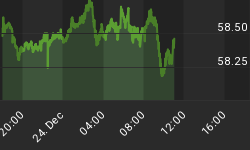Bonds Have Not Turned vs. Stocks

In the wake of Wednesday's Fed announcement, the exchange traded fund (ETF) landscape was aligned with the consensus forecast for monetary policy. From The New York Times:
The Federal Reserve, still uncertain that the American economy can grow unaided, announced on Wednesday it would press ahead with its stimulus campaign of asset purchases and low interest rates. Fed officials had spent much of the summer preparing investors for a retreat from the bank's stimulus campaign before the end of the year. That remains a possibility: The Fed's policy-making committee is scheduled to meet for the final time this year in mid-December. But analysts increasingly expect that the Fed will continue with the present pace of asset purchases well into next year.
Relative Demand Speaks To Investor Conviction
As we have outlined on several occasions, investors of all sizes, from hedge funds to the local stock club, reveal their economic convictions with their wallets. Relative demand (buying conviction vs. selling conviction) ultimately sets asset prices. Common sense tells us when the demand for stocks is greater than the demand for bonds, the aggregate economic outlook of all market participants is "net bullish". Conversely, when the demand for conservative bonds is greater than the demand for growth-oriented stocks, the aggregate economic outlook of all market participants is "net bearish". Stocks go up under net-bullish conditions. Stocks go down under net-bearish conditions.
Bonds Must Be Winning This Week, Right?
The weekly chart below shows the performance of bonds (AGG) relative to the S&P 500 (SPY) as of Wednesday's close. When the ratio falls, it reflects weak demand for bonds relative to demand for stocks. Even with a risk-off session in stocks Wednesday, AGG is still lagging the S&P 500 by 0.31% this week. For us to become more concerned and to make the stock market bears happier, the chart below needs to flip from a bearish trend to a bullish trend.

You may disagree with the market's take on the chart above. However, as we outlined in detail on October 25, the aggregate opinion of all market participants determines the value of our investments; not personal opinions. It can be expensive to wait for the market to align with our personal outlook. We are open to making adjustments when the chart above begins to align with a risk-off look.
Weekly Demand "Confirming" Current Trends
AGG is an aggregate basket of bonds from all walks of fixed income life. Are we seeing the same bullish economic conviction signals when we compare other types of bonds to the S&P 500? Yes, the table below includes numerous bond ETFs that were making new weekly lows vs. the S&P 500 this week. The table tells us there is no stealth defensive action taking place behind the scenes. If investors were concerned about slow economic growth/and or deflation, we would expect to see them gravitating toward bonds. The table below shows the weekly change of each ETF relative to the S&P 500 as of Wednesday's close. Many defensive ETFs, such as Treasuries (TLT), are trying to nail down new weekly closing lows relative to the stock market.

What Spooked The Markets?
Financial markets have become accustomed to extraordinarily loose monetary conditions. After the Fed's statement, SPY dropped to finish down 0.50% for the session. The more troubling close was TLT finishing the day at a loss of 0.60%. The markets may have been focusing on the "we see some economic improvement" portions of today's Fed statement, which could have been interpreted as "tapering is still on the way". From Wednesday's FOMC statement:
The Committee sees the downside risks to the outlook for the economy and the labor market as having diminished, on net, since last fall...Taking into account the extent of federal fiscal retrenchment over the past year, the Committee sees the improvement in economic activity and labor market conditions since it began its asset purchase program as consistent with growing underlying strength in the broader economy...To support continued progress toward maximum employment and price stability, the Committee today reaffirmed its view that a highly accommodative stance of monetary policy will remain appropriate for a considerable time after the asset purchase program ends and the economic recovery strengthens.
Investment Implications - Cracks Require Flexibility
Our market model told us to start redeploying cash on October 10 based on the observable improvement in the market's tolerance for risk. Over the long haul, early entry points off a correction low allow you to give your positions more rope when volatility arrives.

The damage from Wednesday's session did little to disturb the market's longer-term risk tolerance profile, which is easy to understand when you consider the S&P 500 is still up 3 points for the week. However, we have seen some emerging cracks over the past two weeks. Demand for bonds has not surpassed stocks, but there is evidence of an attempt to mount a more formidable charge relative to stocks. Recent interest in defensive consumer staples (XLP) also tells us to keep an open mind about a "give back" after the S&P 500 gained 129 points from the October 9 low to the recent high. The observable evidence in the table above aligns with a growth-oriented allocation, including exposure to broad U.S. stock market (VTI), emerging markets (EEM), foreign stocks (EFA), and technology (QQQ).
















